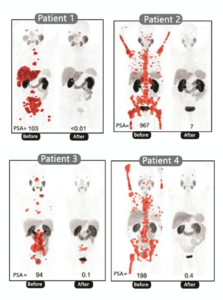177Lutetium-PSMA
Therapeutic radioactive doses for Prostate Cancer
Peptide-Receptor Radionuclide therapy (PRRT)
General Concept
- Prostate cancer cells have receptors on their surface called prostate specific membrane antigen (PSMA).
- We perform diagnostic PET/CT study using 68Gallium-PSMA to detect tumors in the body and confirm presence of receptors on tumor cells.
- We then inject the therapeutic dose (177Lutetium-PSMA). 177Lutetium emits short ranged Beta rays of average length of 0.23mm leading to tumor cell damage and at the same time low risk to surrounding healthy cells.


